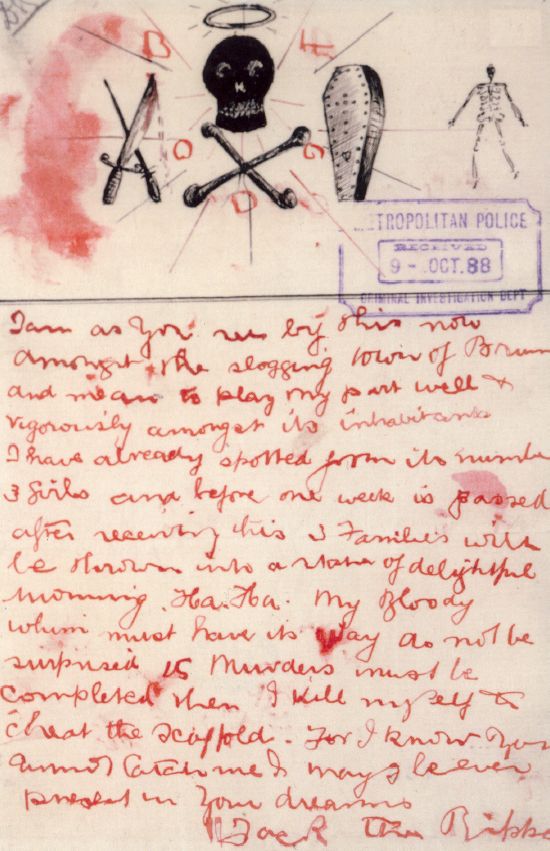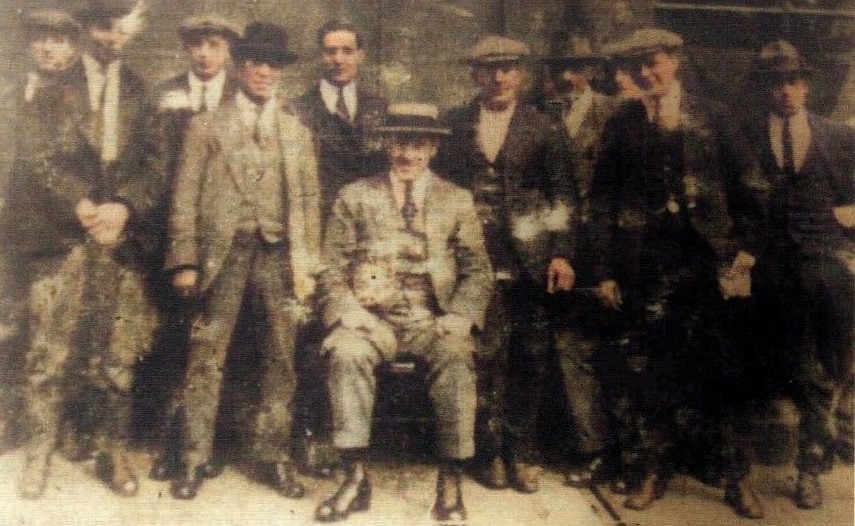This isn't something I think likely, or even plausible. But, while I've seen the idea that "Jack The Ripper" may actually have been a street gang member bandied about, I've never seen the notion that he may have been a Sicilian Black Hander mooted.
Again, note that I don't believe this. I take it as a matter of faith that the Ripper was a lone wolf serial killer motivated by psychosexual issues, either an Englishman or an Irishman or an Eastern European, probably but not definitely local to the East End. But still, in a field starved for novel theories like the Ripper killings, this probably qualifies.
Before the Mafia, there was the Black Hand. These were like, but not identical to, the Mafia of later decades; there was no organized 'Black Hand' as an entity, though some American policemen and journalists thought otherwise. There seem rather to have been small groups of Sicilian mobsters, sometimes even solitary individuals, who collectively became known as the 'Black Hand' because of the extortion letters they sometimes sent to their victims.
Per Mike Dash's masterful work on the subject of the early mob, The First Family:
It was this description of the Black Hand letters that made me think of some of the "Ripper letters", and, indeed, they bear a vague resemblance to each other.
Compare and contrast:
"The Ripper"

"The Black Hand"

Obviously there are things that argue against any such connection between these two particular letters - the Black Hand letter is in Italian, for instance. But not all Black Hand letters were. Ibid Dash:
Now I'm very aware that there's no evidence that "the Ripper" actually wrote any of the letters ascribed to him (though I personally would give pretty strong credence to the Lusk letter), and that none of them seem to have tried to extort anything from anybody, and that seemingly few of them were decorated with little occult pictures like the one I posted above.
Like I said, I don't actually believe this theory.
But suppose for the sake of supposing. The attack on Emma Elizabeth Smith was made by a group of ruffians who shoved something in her vagina, or so she claimed. That, at least, seems to have been a gangland slaying, of the sort. Would it not be at least possible that some of the broader attacks on prostitutes in the Autumn of Terror may have been gang-related? Perhaps, say, a new gang moving into the area and trying to run those prostitutes associated with local, native gangs off the streets?
This is my imagination running away with me: a tiny group of Sicilians in the East End decides to break into the prostitution racket. They figure they need to get rid of the local whores associated with native East End gangs to do so. They attack Smith to send a message to those gangs. It doesn't work. So one of the more courageous of their number takes it upon itself to begin sending that message more directly - but in the process creates a myth that takes on a life of its own.
Were there any Sicilians in the East End at all? New York City was already teeming with Italians by 1888, but I can find none in London at the time: but I also do not have any census figures available to me.
Don't shoot the messenger. I'm not proposing this as a serious theory - but it's kind of fun to moot an idea of your own invention. At the least it goes to show how easy it is to invent a suspect out of whole cloth.
Again, note that I don't believe this. I take it as a matter of faith that the Ripper was a lone wolf serial killer motivated by psychosexual issues, either an Englishman or an Irishman or an Eastern European, probably but not definitely local to the East End. But still, in a field starved for novel theories like the Ripper killings, this probably qualifies.
Before the Mafia, there was the Black Hand. These were like, but not identical to, the Mafia of later decades; there was no organized 'Black Hand' as an entity, though some American policemen and journalists thought otherwise. There seem rather to have been small groups of Sicilian mobsters, sometimes even solitary individuals, who collectively became known as the 'Black Hand' because of the extortion letters they sometimes sent to their victims.
Per Mike Dash's masterful work on the subject of the early mob, The First Family:
To many New Yorkers, including the reporters of the English-language press, the most compelling feature of these cases was the bizarre decorations that adorned the extortion letters. Demands were accentuated with crude drawings of skulls, revolvers, and knives dripping with blood or piercing human hearts. Many also featured pictures of hands, in thick black ink, held up in the universal picture of warning. It was this last feature that inspired a journalist writing for The New York Herald to refer to the communications as "Black Hand" letters - a name that stuck, and, indeed, soon became synonymous with crime in Little Italy...
Compare and contrast:
"The Ripper"

"The Black Hand"

Obviously there are things that argue against any such connection between these two particular letters - the Black Hand letter is in Italian, for instance. But not all Black Hand letters were. Ibid Dash:
The letters, which were always anonymous, were often phrased in bizarrely courteous Old World language, but the underlying threat of violence was ever present. "I beg you warmly," one suvch missive concluded, "to put them [the bank notes] on your door within four days. But if not, I swear this week's time not even the dust of your family will exist." Another, even blunter, letter warned:
You got some cash. I need $1000.00. You place the $100.00 bills in an envelope and place it under a board at the corner of 69th Street at eleven o'clock tonight. If you place the money there, you will live. If you don't, you die. If you report this to the police, I'll kill you when I get out. They may save your money but they won't save your life.
You got some cash. I need $1000.00. You place the $100.00 bills in an envelope and place it under a board at the corner of 69th Street at eleven o'clock tonight. If you place the money there, you will live. If you don't, you die. If you report this to the police, I'll kill you when I get out. They may save your money but they won't save your life.
Now I'm very aware that there's no evidence that "the Ripper" actually wrote any of the letters ascribed to him (though I personally would give pretty strong credence to the Lusk letter), and that none of them seem to have tried to extort anything from anybody, and that seemingly few of them were decorated with little occult pictures like the one I posted above.
Like I said, I don't actually believe this theory.
But suppose for the sake of supposing. The attack on Emma Elizabeth Smith was made by a group of ruffians who shoved something in her vagina, or so she claimed. That, at least, seems to have been a gangland slaying, of the sort. Would it not be at least possible that some of the broader attacks on prostitutes in the Autumn of Terror may have been gang-related? Perhaps, say, a new gang moving into the area and trying to run those prostitutes associated with local, native gangs off the streets?
This is my imagination running away with me: a tiny group of Sicilians in the East End decides to break into the prostitution racket. They figure they need to get rid of the local whores associated with native East End gangs to do so. They attack Smith to send a message to those gangs. It doesn't work. So one of the more courageous of their number takes it upon itself to begin sending that message more directly - but in the process creates a myth that takes on a life of its own.
Were there any Sicilians in the East End at all? New York City was already teeming with Italians by 1888, but I can find none in London at the time: but I also do not have any census figures available to me.
Don't shoot the messenger. I'm not proposing this as a serious theory - but it's kind of fun to moot an idea of your own invention. At the least it goes to show how easy it is to invent a suspect out of whole cloth.




Comment